Enhanced TDS
Identification & Functionality
- RTU Product Type
- Technologies
- Product Families
Features & Benefits
- Ready-to-Use Product Features
- Product Properties
- High shear and peel strength
- Tough and resilient
- Good resistance to dynamic loading
- Bonds a wide variety of materials
Applications & Uses
- Application Area
- Compatible Substrates & Surfaces
- Markets
- Applications
- Applications
- It is suitable for bonding a wide variety of metals, ceramics, glass, rubbers, rigid plastics and most other materials in common use.
- The resin/hardener mix is applied with a spatula to the pretreated and dry joint surfaces.
- A layer of adhesive 0.05 to 0.10 mm thick will normally impart the greatest lap shear strength to the joint.
- The joint components should be assembled and clamped as soon as the adhesive has been applied.
- An even contact pressure throughout the joint area will ensure optimum cure.
- Processing Information
Pretreatment
- The strength and durability of a bonded joint are dependant on proper treatment of the surfaces to be bonded.
- At the very least, joint surfaces should be cleaned with a good degreasing agent such as acetone or other proprietary degreasing agents in order to remove all traces of oil, grease and dirt.
- Low-grade alcohol, gasoline (petrol) or paint thinners should never be used.
- The strongest and most durable joints are obtained by either mechanically abrading or chemically etching (“pick-ling”) the degreased surfaces.
- Abrading should be followed by a second degreasing treatment.
Property Parts by Weight
Parts by Volume
Araldite® AW 146 100 100 Hardener HV 957 80 100 - Resin and hardener should be blended until they form a homogeneous mix.
Mechanical processing
- Specialist firms have developed metering, mixing and spreading equipment that enables the bulk processing of adhesive.
Equipment maintenance
- All tools should be cleaned with hot water and soap before adhesives residues have had time to cure.
- The removal of cured residues is a difficult and time-consuming operation.
- If solvents such as acetone are used for cleaning, operatives should take the appropriate precautions and, in addition, avoid skin and eye contact.
Times to minimum shear strength
Temperature (°C) 10 15 23 40 60 100 Cure Time to Reach >1 N/mm² (hours) 24 12 7 2 - - LSS > 1 N/mm² (minutes) - - - - 30 6 Cure Time to Reach >10 N/mm² (hours) 36 18 10 3 - - LSS > 10 N/mm² (minutes) - - - - 45 7 LSS = Lap shear strength.
Properties
- Physical Form
Technical Details & Test Data
- Cured Properties
Typical Cured Properties
- Unless otherwise stated, the figures given below were all determined by testing standard specimens made by lap-jointing 114 x 25 x 1.6 mm strips of aluminium alloy. The joint area was 12.5 x 25 mm in each case.
- The figures were determined with typical production batches using standard testing methods. They are provided solely as technical information and do not constitute a product specification.
Average lap shear strengths of typical metal-to-metal joints (ISO 4587) (typical average values)
- Cured for 16 hours at 40°C and tested at 23°C.
- Pretreatment - Sand blasting and degreasing
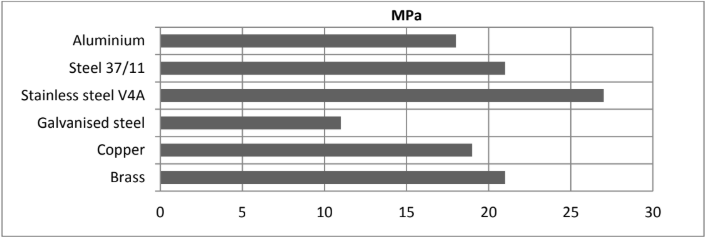
Average lap shear strengths of typical plastic-to-plastic joints (ISO 4587) (typical average values)
- Cured for 16 hours at 40°C and tested at 23°C.
- Pretreatment – Lightly abrade and alcohol degrease.
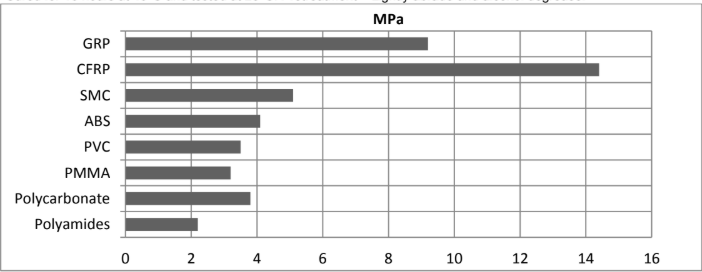
Lap shear strength versus temperature (ISO 4587) (typical average values)
- On aluminium.
- Pretreatment - Sand blasting.
- Cure: (a) = 7 days /23°C;
- Cure: (b) = 24 hours/23°C + 30 minutes/80°C
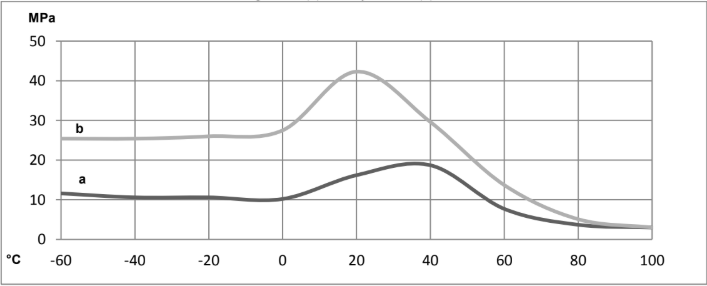
Property Value Unit Test Method at Condition Roller peel test (etched aluminium) 3.5 N/mm ISO 4578 Cure: 48 hours at 20°C
Roller peel test (etched aluminium) 5.5 N/mm ISO 4578 Cure: 16 hours at 40°C
Roller peel test (etched aluminium) 5.5 N/mm ISO 4578 Cure: 2 hours at 80°C
Flexural Strength 46 MPa ISO 178 Cure: 16 hours at 40°C, tested at 23°C
Flexural Modulus 1654 MPa ISO 178 Cure: 16 hours at 40°C, tested at 23°C
Lap shear strength versus immersion in various media (ISO 4587) (typical average values)
- On aluminium, cured for 16 hours at 40°C and tested at 23°C.
- Pretreatment - Sand blasting.
- Unless otherwise stated, L.S.S. was determined after immersion for 30, 60 and 90 days at 23°C.
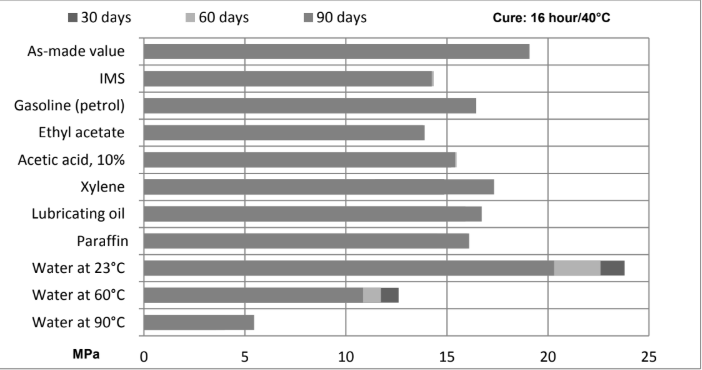
Lap shear strength versus tropical weathering (ISO 4587) (typical average values)
- (40°C/ 92% RH), on aluminium, cured for 16 hours at 40°C and tested at 23°C.
- Pretreatment - Sand blasting

Lap shear strength versus heat ageing (ISO 4587) (typical average values)
- On aluminium, cured for 16 hours at 40°C and tested at 23°C.
- Pretreatment - Sand blasting

Additional electrical properties
Property Value Unit Test Method Dielectric strength 425 Volt/mil ASTM D-149 Surface resistivity 1.5 E+15 Ω IEC 60093 Volume resistivity 5.7 E+14 Ω·cm IEC 60093 Dielectric constant at 50Hz/1kHz/10kHz 4.4 / 4.4 / 4.3 - IEC 60250 Loss tangent at 50Hz/1kHz/10kHz 0.8 / 0.7 / 1.0 % IEC 60250 - Cured Properties
Typical Cured Properties
- Unless otherwise stated, the figures given below were all determined by testing standard specimens made by lap-jointing 114 x 25 x 1.6 mm strips of aluminium alloy. The joint area was 12.5 x 25 mm in each case.
- The figures were determined with typical production batches using standard testing methods. They are provided solely as technical information and do not constitute a product specification.
Average lap shear strengths of typical metal-to-metal joints (ISO 4587) (typical average values)
- Cured for 16 hours at 40°C and tested at 23°C.
- Pretreatment - Sand blasting
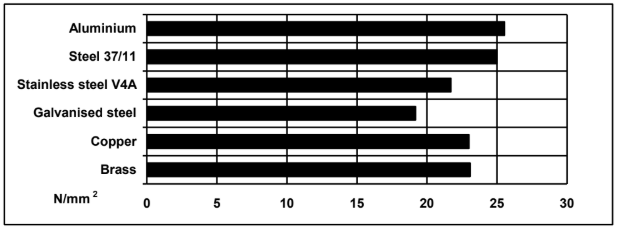
Lap shear strength versus temperature (ISO 4587) (typical average values)
- Cure: (a) = 7 days /23°C
- Cure : (b) = 24 hours/23°C + 30 minutes/80°C
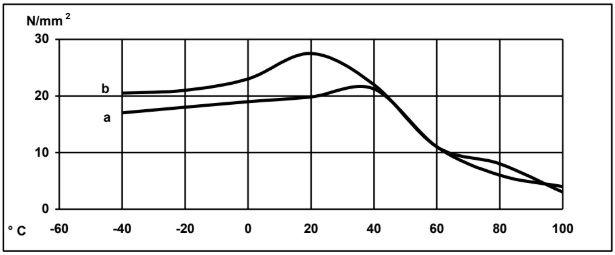
Property Value Unit Test Method at Condition Roller peel test 5 N/mm ISO 4578 Cure: 16 hours at 40°C
Shear modulus at -50°C 2 GPa DIN 53445 Cure: 16 hours at 40°C
Shear modulus at 0°C 1.3 GPa DIN 53445 Cure: 16 hours at 40°C
Shear modulus at 25°C 0.6 GPa DIN 53445 Cure: 16 hours at 40°C
Shear modulus at 50°C 0.2 GPa DIN 53445 Cure: 16 hours at 40°C
Shear modulus at 75°C 15 MPa DIN 53445 Cure: 16 hours at 40°C
Shear modulus at 100°C 7 MPa DIN 53445 Cure: 16 hours at 40°C
Lap shear strength versus immersion in various media at 23°C (typical average values)
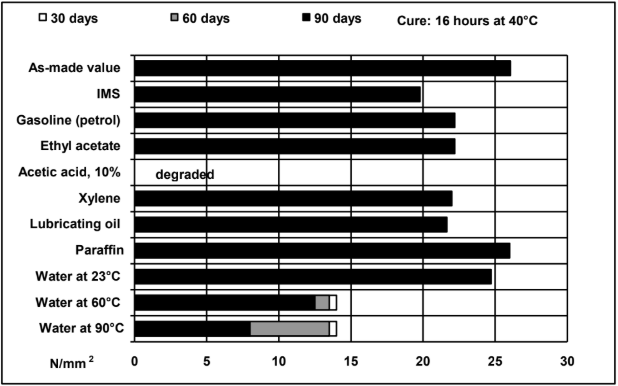
Lap shear strength versus tropical weathering
- 40/92, DIN 50015; typical average values

Lap shear strength versus heat ageing
- Cure: 16 hours at 40°C, test at 23°C, 50% rh
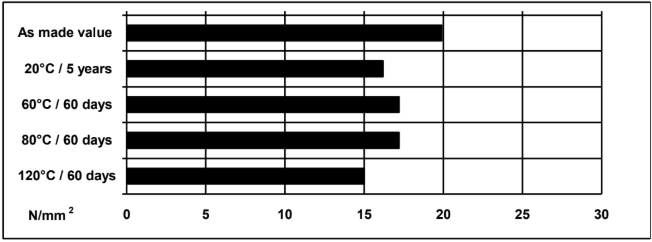
Storage & Handling
- Storage and Handling Precautions
Storage
-
Araldite® AW 146 may be stored for up to 3 years at room temperature and Hardener HV 957 may be stored for up to 2 years provided the components are stored in sealed containers.
Handling Precautions
- Our products are generally quite harmless to handle provided that certain precautions normally taken when handling chemicals are observed.
- The uncured materials must not, for instance, be allowed to come into contact with food- stuffs or food utensils, and measures should be taken to prevent the uncured materials from coming in contact with the skin, since people with particularly sensitive skin may be affected.
- The wearing of impervious rubber or plastic gloves will normally be necessary; likewise the use of eye protection.
- The skin should be thoroughly cleansed at the end of each working period by washing with soap and warm water.
- The use of solvents is to be avoided. Disposable paper - not cloth towels - should be used to dry the skin.
- Adequate ventilation of the working area is recommended.
-
Other
- Appearance
- Pale yellow
- Application Information
Value Units Test Method / Conditions Mix Ratio 0.8 %(W) %(W) Hardener : Resin - Physical Properties
Value Units Test Method / Conditions Specific Gravity approx. 1.05 - Viscosity 30.0-45.0 Pa.s Pa.s
